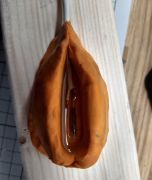|
FISHMANPET posted:Also the joys of a Minnesota fall, during the day it's 65 and sunny (heating up the house to over 70) and at night it gets down into the 50s. Because reasons, opening windows doesn't really do anything for cooling off the house when it cools down outside. I'm guessing that because it's cold outside that it's easy for the heat pump outside to discharge heat, so running the mini-splits in cooling mode isn't going to be using a whole lot of energy, right? If you're not cooling off the house just by opening the windows, its because you aren't getting any air exchange for whatever reason. Combine open windows and a ventilation fan to move cold air in and hot air out. Some houses has attic fans to do this. But yes, cooler outside temps make acs use less energy to a point.
|
|
|
|

|
| # ? May 16, 2024 16:01 |
|
Is there some way I could have damaged my blower by miswiring the humidifier solenoid? It stopped working overnight and now just makes a loud whining when trying to turn on. It did work yesterday evening after I disconnected the humidifier
|
|
|
|
So the issue was a clog inside the inducer motor that I wasn't able to clear without taking it off (which I didn't feel comfortable doing). They did run it for a bit and he showed me the flames on the burner how they would sometimes flare orange and said the heat exchanger may be cracked and the furnace may need to be replaced. Furnace is 13 years old, probably has never had annual service (it was previously a rental property that we bought to live in, there's a lot of poo poo that needs fix'n) After doing some research it looks like to really see if it's cracked you'd need a camera inspection, which was not done, or a combustion test, which was not done. I will note that in the spring we had insulation installed, and before the company was allowed to install the insulation they had to do a combustion test, and they said it tested normally. We have CO detectors in the living space and in the basement where the furnace is. How concerned should I be? Are there any steps we can take to verify if it is cracked? I've called a few other HVAC companies to try getting some quotes. If we have to replace the furnace it's not the worst thing since the furnace that's there currently is an 80% and my state has a program to subsidize the cost of 95% or 97% furnaces. e: also thinking of a central heat pump system to replace the furnace and central AC, if anyone has experience with those. In Massachusetts, so our winters don't usually go below like 5F on the coldest days. The Slack Lagoon fucked around with this message at 03:12 on Nov 9, 2021 |
|
|
|
It is Possible that you have heat exchanger issues at that age. A combustion analyzer in the discharge from the furnace would be able to tell, as well as a camera inspection.
|
|
|
|
I'm helping my brother air-condition his house. Right now he has no cooling at all, because Stockholm normally isn't super hot and house AC hasn't really been a thing historically. His house is equipped with a geothermal heat pump for heating both hot tap water and the heating water that goes to radiators and convectors. The heat pump pumps its heat from a sealed circuit filled with an ethanol/water mix (that everyone calls "brine" for some reason, sometimes it's glycol based too) that goes in a long hose down the bottom of the 100m+ deep thermal well and up again. The heat pump gets brine at 6 degrees Celsius in, and it sends 4C back down the well, pretty much. 6C is a normal and good thermal well temperature where we live. The plan is to route the brine from the thermal well into the attic space, into a water-to-air heat exchanger. After this it's pretty conventional house AC I think. Brother knows electricity, I've done a bunch of plumbing (we'll use copper with mainly pressed fittings for the ethanol brine because of the fire code and probably pex for the condensation drain) but none of us have any experience with air conditioning or ventilation. I should probably mention that the point of this whole deal is to get what is essentially free cooling during the occasionally hot summer months since there's an endless supply of cool brine. The only energy costs will be the brine circulation pump and the air blower. Depending on RPM on the rotating bits it should be in the range of a few hundred Watts of power at most to get several kW worth of cold air. These kind of systems aren't unheard of here, but they're not exactly common either. The plan for the air side of things is basically a thick duct (250 mm) picking up air at a single point in a central hallway ceiling. This will be routed in a horseshoe shape round the perimeter of the attic space through a dust filter, a blower, the heat exchanger and a bunch of outlets. Where the main duct is over a room we wish to cool, we'll use a T-piece to a narrower duct (125mm) that goes into an adjustable ceiling air outlet. There will be about 7 of these ceiling outlets. The plan is to balance the airflow between the rooms using the adjustable outlets, and regulate the temperature with a single air temp sensor controlling the RPM on the air blower. The brine pump will likely run at a constant, sufficiently high RPM unless the heat pump needs the brine for making hot tap water, when there won't be any AC at all for a few minutes every now and then. It is probably possible to route the heat pump and attic air cooler in series if this turns out to be a problem but right now they are parallel, so it's one or the other (the plumber who recently replaced the 20 year old broken heat pump installed copper fittings on the existing brine circuit for this so that's the only part of the project that is done already) Parts and materials for the whole shebang should cost 3000-4000 euro or so. A few things I want to know: -Does any part of this sound dumb? -what is the easiest way to insulate air ducts to prevent condensation? -Are flexible air ducts fine or are hard ducts clearly superior? -What needs to be done to muffle the sound of the blower and the moving air? -I've always heard that pex tube/hose can stand water freezing inside it without issue. Is this actually true?
|
|
|
|
That mostly sounds good. Only thing I’m not sure of is your pump set up. You would need to make sure you have controls to turn your cooling pump off when the water heater pump kicks on. Running them in series isn’t a bad option, since you’re getting colder water after the heater, but 6C is plenty cold enough. For insulation, you can get duct wrap at any hardware store. They make sleeves that go over round duct, which is easier than trying to tape it all up. Another option is to get lined duct. This has the added benefit of also making your system quieter. You just need to make sure you order your duct that way. Not sure standard thickness in Europe, US I often see 1-1/2” thick fiberglass on supply air. Keep in mind, you need to make your duct bigger to account for the liner. Install canvas connectors onto your fan connections too. This helps stop the vibration of the fan from carrying all the way down your duct. Flex duct is typically only used 5’ (1.5m or so) from your diffuser, but people have been known to use it for longer runs, especially in homes.
|
|
|
|
You get 6c back from your geo well year round?
|
|
|
|
Thanks for feedback. Duct wrap might be commonly available where you live, but these things aren't really common or available here, at least not in any big box stores that cater to amateurs. I'm sure we can order it though, or worst case improvise something. There's more than one way to skin a cat, so I wouldn't be at all surprised if what's available in norther Europe is totally different than what is common in the US. I know lots of our plumbing/electrical/normal house construction practices and materials differ and it's likely that the same goes for moving air around. The reason for considering flexible duct is the space available. The house is rectangular and has what I think is called a hip roof, at least that's the shape of it. I don't know the words to describe the structure of the framing, but there's lots of lumber and zig-zags spaced about 1 meter apart going across the rectangle. We've added more insulation to the bottom of the attic and put in a floor up there for storage, and we'd like most if not all of the ducting to go past the outside edge of this floor, into the wedge where the outer roof meets the attic floor - or rather the top of the insulation, since the lack of headroom made it senseless to floor all the way out. The point is that it would be very difficult to manoeuvre any lengths over about 1.5 m of hard ducting into this space because of all the lumber holding the roof up, so using mainly flexible ducting seems attractive for this reason. As for turning the A/C brine pump off when the heat pump is making tap water my brother has assured me it's no biggie, and I have great confidence in his considerable electrical/electronic abilities. The heat pump is pretty beefy and puts out 12kW at full tilt, so hot water production doesn't take long or happen very often. It's a modern unit with RPM control on the compressor so this time of year it's mostly slowly ticking over keeping the radiators warm, but when it switches over to making hot water it goes full tilt, at least it sound like it does. Hopefully the house won't heat up noticeable when it happens. Bro will probably use an arduino to control the blower speed, I'm sure he'll program it so it knows not to to turn the blower at full blast in futile cooling attempts during the hot water making phase. We already figured we want to isolate the blower mechanically to keep vibrations local and avoid resonance. I'm not sure I've ever seen canvas connectors, but I'm sure we can find something flexible that does the job.
|
|
|
|
MRC48B posted:You get 6c back from your geo well year round? Yeah. It's deep. There's probably water flowing down there or the well would have cooled off after 20 years of use.
|
|
|
|
Invalido posted:
They take it better, but its still not good.
|
|
|
|
It’s not unheard of to use flex all over the place. The problem with too much flex is that friction loss is higher, and it can be easily crushed, which can cause some obvious problems. You can get insulted flex too, so that can help with your insulation issues. If you’re worried about your coil freezing, just drain it every winter. Not sure what the freezing point of the brine is. The condensate drain you could blow out the trap every winter too. Otherwise there shouldn’t be any other water to freeze. Bird in a Blender fucked around with this message at 16:18 on Nov 14, 2021 |
|
|
|
MRC48B posted:They take it better, but its still not good. Huh. That sucks a little bit. There's two PVC sewer vents going through the attic and I was planning to drain to either of those. If I could just run hose and allow water to block off a low point there's no risk of sewer smell entering the air. If I use something more flexible like high quality garden hose maybe I can just let it freeze in the winter. I guess a constant downslope is possible but it's more work and will take away more storage space in the attic. And I would perhaps need some kind of smell trap. Other drainage options are possible but less elegant. As for the coil freezing I doubt it's an issue. The brine is supposed to be good down to -24C which Stockholm rarely sees. The attic should be slightly above ambient due to spill heat from below, and there should be some convection of heat through the ducts as well. But maybe it's best to plan for draining the cooling circuit each fall to be totally sure. There's going to be copper tubing well away from the ducting after all.
|
|
|
|
I've got these capped 4in extensions off my ductwork in the basement and I'm routing some flexible duct off them so I'm not constantly freezing in my "office". I'm looking for a piece that'll allow me to shut this extension off at the source rather than just letting heat dissipate off it when im not there. I feel like this is something that should be common and easily found but I haven't had any luck. 
|
|
|
|
You are looking for a "damper", which does exist.
|
|
|
|
specifically a manual balance damper
|
|
|
|
How hard is it to air seal ductwork? It has become clear that whoever installed our system did a poo poo job and it's not sealed very well. It's all accessible form the unfinished basement. Some of it is metal ducting and some is insulated flex pipe. I have an IR camera and I can easily find the leaks.
|
|
|
|
MRC48B posted:specifically a manual balance damper That's the key phrase right there. Managed to find one that wasn't $80 too. Thanks.
|
|
|
|
The Slack Lagoon posted:How hard is it to air seal ductwork? It's about as hard as buying a bucket of air duct sealant and a paintbrush or two. Probably some gloves too; the stuff is messy, but usually water soluble. Have fun!
|
|
|
|
Wondering what the thread's opinions and experiences are regarding electronic air purification devices. Since COVID began my company bought and has been having me install these needlepoint bi-polar ionization devices in various assisted living facilities across West Texas. They're manufactured by a company called Global Plasma Solutions which claims that their product works by generating and releasing negative ions into the air. These in turn then bind to airborne pollutants and viral particles which allegedly makes them fall or bind to surfaces/filters easier. Now, I'm a recent mariner-turned-HVAC tech with little knowledge of air quality control, so I decided to look up these devices after a job. The first thing I found is that Global Plasma Solutions is currently the defendant in a class action false advertising lawsuit claiming that the company-funded studies, on which they based their virus-neutralizing claims, used unrealistic conditions for their tests, basically testing them in the air volume equivalent of a large shoebox instead of like, an office building. Independent studies conducted by scientists at the University of Colorado and others seem to suggest that the devices do very little compared to solutions like HEPA filters. I mentioned the lawsuit to our sales manager who quickly dismissed my concern, understandably so as the company stands to make money on these devices regardless... So I have this awful feeling that I'm installing scam devices at these facilities ostensibly trying to protect their charges but I don't know what to do about it. I haven't found any definitive answers about the devices other than "we need more data" but a little part of me dies every time an elderly resident asks me what I'm doing with their air conditioner on these jobs. Anyone else work with these things or similar devices? fibblins fucked around with this message at 00:53 on Nov 18, 2021 |
|
|
|
Ionizers do improve IAQ. what they don't do is help with covid transmission. hospitals are built in a very specific way, you can't jury rig your way to a hospital grade hvac system with addons like that. people have been trying stupid poo poo like high merv filters and 100% oa since it crossed the pond. doesn't work when some unmasked idiot is breathing in your face. "can I put hepa filters in my beatass rooftop from 1993 to prevent covid? MRC48B fucked around with this message at 02:58 on Nov 18, 2021 |
|
|
|
Yeah, we put a GPS ionizer in our house way before this for air quality. It definitely makes more stuff stick to the filter, but it's not magically effective against viruses You're putting them in because it's the cheapest mitigation out there. If you feel bad, think of all the asthmatics you're unintentionally helping.
|
|
|
|
It's me. I'm the idiot. Didn't realize the signs until yesterday that our condensate line was clogged again, because apparently vinegar once a month doesn't cut it for me in this climate. Two minutes of shop-vaccing the line and eight hours without cooling later, we're back to our normal temperature. Guess I'll try every three
|
|
|
|
D34THROW posted:It's me. I'm the idiot. You might try getting a snake down it too
|
|
|
|
D34THROW posted:It's me. I'm the idiot. Where do you live that your condensate is getting clogged up every month? Are you sure it's biological and you're not getting rust or something into the drain? Rust would indicate other problems.
|
|
|
|
SpartanIvy posted:You might try getting a snake down it too I have had no luck finding a good plumbing snake; would it be harder to find one to fit the 1/2"-3/4" PVC drain line? Bird in a Blender posted:Where do you live that your condensate is getting clogged up every month? Are you sure it's biological and you're not getting rust or something into the drain? Rust would indicate other problems. It's not getting clogged every month; I'm in Florida and the unit was installed last August and clogged twice since then. I'm putting half a cup of vinegar down the line a month per the guy's recommendations. What's coming out of the (PVC) drain is a big ol' bolus of slimy algae and stale dark water. However, given that the previous unit was at least a decade old I think, because it could take both freon and puron (this new one takes only puron), it's possible that rust from the old unit hangs out in the line. Then again, I think they flushed it when they put in the new unit.
|
|
|
|
D34THROW posted:I have had no luck finding a good plumbing snake; would it be harder to find one to fit the 1/2"-3/4" PVC drain line? RIDGID PowerSpin Plus https://www.homedepot.com/p/RIDGID-PowerSpin-Plus-57043/303644607 SKU# 303644607 I highly recommend you go with one that can attach to a drill. It's 10,000x better to use.
|
|
|
|
fibblins posted:Wondering what the thread's opinions and experiences are regarding electronic air purification devices. HEPA filters or bust. I'm going to suggest the AustinAir units. It won't stop people not wearing masks, but it will actually suck airborn stuff out of the air. Will it reduce covid transmission? Unlikely. Will everyone there breathe easier? Yes.
|
|
|
|
Hey I posted this in the home automation thread but maybe it is better here. Our apartment has a gas boiler that provides hot water and runs the radiators. I'd like to replace the old thermostat with a smart one. Does anyone have an opinion on either of these? https://www.netatmo.com/en-eu/energy/thermostat https://www.tado.com/all-en/smart-thermostat I like that they are wireless and have the option to add individual control units to the radiators. The location of the current thermostat is really bad but the apartment walls are brick so moving the wiring is not something I want to bother with. That is why having a wireless thermostat is appealing. From looking at the documentation and installation video of the Netatmo device I think it is exactly what I need. It provides a wifi relay device which is connected directly to the boiler; it gets power from it and controls turning the radiators on and off. Then there is a separate wireless thermostat device which you can set the temp on etc, or just use the app. The tado seems similar but instead of a relay box it has something they refer to as a wireless receiver which they say "also operates as a hot water programmer". I don't think this is a feature our old as poo poo boiler can use but I have no idea. And I can't tell if this wireless box serves the same function as the netatmo relay box as well. Also also tado apparently charges €3/month to use the geofencing feature which kills me. The netatmo doesn't even have this feature but i surely don't want to pay a subscription for a thermostat feature i mean gently caress.
|
|
|
|
Now just why in the gently caress is my just-cleaned-in-August, installed-last-year AC unit having freezing issues on half of the coils? I just changed the drat air filter one or two days ago. Also, the un-insulated copper line is sweating - I'm assuming, based on the other copper line having half an inch of foam wrapped around it, that the un-insulated one is the return line?
|
|
|
|
My guess is you have a leak some place and the low refrigerant is causing the coils to freeze. Normally, the insulated line is the suction going to the condensing unit.
|
|
|
|
Freezing Coils Checklist: Airflow issues: Filter Dirty (just replaced) Coils Dirty (Unit new, unlikely) Other Airflow issue, obstruction, fan issue, etc (?) Refrigerant issues: Flow issue, metering device not working correctly. Leak, system below optimum charge level. either way, 1yr old. time for a warranty callback.
|
|
|
|
Anyone have experience with central heat pump to warm air system in places that get below freezing? Trying to decide if I should go with central heat pump with electric resistance heat backup or a NG furnace with a heat pump on top, running the heat pump down until efficiency drops and swapping to the NG.
|
|
|
|
The Slack Lagoon posted:Anyone have experience with central heat pump to warm air system in places that get below freezing? This depends on how frequently you drop below the efficiency range of your heat pump and how much both electric and gas cost, how long you plan to be in the house, and how much extra the fossil source and controller are going to cost. It's pretty much just a mathematical calculation.
|
|
|
|
The Slack Lagoon posted:Anyone have experience with central heat pump to warm air system in places that get below freezing? What area? There's a big difference in degree days between say, the Midatlantic and upper Northeast. In the suburbs of Philly where I am, heat pumps with electric backup are pretty popular. Mostly because NG infrastructure is limited and our electric is reasonable (12-13 cents kWh.) If you already have a gas meter and use gas for other things (aka, you're not dropping the meter fee), a HP with NG backup is probably going to be hard to beat. I did the calc around here, and with a basic HP and NG prices as of last year (they're higher this Winter), the optimal cutover was around 40F.
|
|
|
|
The Slack Lagoon posted:Anyone have experience with central heat pump to warm air system in places that get below freezing? I've worked with air source heat pumps for a few years and installed two of them for my own use - one is a simple cheap air-to-air split unit, the other is an old school 13kW air-to-water system that makes radiator water and tap water for a modest house with poor insulation. What motronic said pretty much, except you have to guess about future energy costs. A good heat pump install can be expected to last 20 years or so. With U.S. electrical generation being what it is I guess natural gas prices should track electrical prices pretty well, but what with the climate crisis this might change over time. Where I live (Sweden) natural gas isn't really a thing so heat pumps are hugely popular. The air-to-air variety (usually small split units) is popular mainly as a retrofit to old houses previously heated with straight electric, but the residential houses here that have central heating are pretty much always on a water system and an air-to-water unit usually goes into those if air-source is used. Those who have the option and can afford it tend to go with geothermal heat pumps even if these have their own issues too. In new construction here geothermal heat pumps combined with water floor heating is considered the pinnacle of heating solutions. Huge surface of your radiators means lower temps on your output, which means the heat pump will perform better. Also heated floors feel good to walk on.  All air source heat pumps have a COP (coefficient of performance) graph similar to this. It varies a bit but below -15C/5F ambient or thereabout it's usually not worth it to run an air source heat pump. While the COP can still be well above 1 (depending on what temps your putting out on the other side, mainly) you'll have real issues with evaporator ice which messes up the duty cycle to the point that all pumps I've ever dealt with shut down and go straight resistive somewhere around those temps. Where I live temps that low are rare and not long in duration so assuming your heat pump is beefy enough to supply enough heat at a lovely COP when your heat need is the largest this might not be an issue.
|
|
|
|
my furnace is throwing a 'pressure switch stuck open' code. would this code stop the induction motor from spinning up or would it stop the furnace from lighting? i bought a (sadly, adjustable) pressure switch that i put in, and found the screw setting point at which the induction blower would begin to run (i replaced the induction motor last year, so I don't think this is the problem, and best as I can tell the exhaust ports should not be blocked) so i have my induction motor going but the furnace refuses to light. it is a high efficiency furnace, so could it be the other pressure switch that's bad? edit: it was the second switch A 50S RAYGUN fucked around with this message at 21:41 on Nov 28, 2021 |
|
|
|
you need to clean out all the drains and tubing on that furnace. switches failing is rare. condensate blockages are far more common.
|
|
|
|
the tubing was clear, and while i don't have a manometer i was getting good exhaust from both the naked blower ports and the tubes going to the switches. the condensate drains take a bit of a weird run through the furnace room so I thought maybe that was it, but they seem to slope correctly, aren't sagging anywhere, and the two clean outs didn't have any standing water in them or that I could clean out.
|
|
|
|
if you checked the trap and tubing in the furnace itself, I guess you're good to go then.
|
|
|
|

|
| # ? May 16, 2024 16:01 |
|
Bird in a Blender posted:My guess is you have a leak some place and the low refrigerant is causing the coils to freeze. Normally, the insulated line is the suction going to the condensing unit. MRC48B posted:Freezing Coils Checklist: My only guess is that when I popped open the faceplate, the foil-backed insulation was flapping in the breeze and getting sucked in blocking airflow. I duct-taped that poo poo back into place so it wouldn't flap around, and now it's fine.
|
|
|






















 Associate Christ
Associate Christ

